“Over The Edge!”
Fresh out of Graduate School from the University of Kansas, I began teaching Figure Sculpture at Santa Rosa Junior College. It was time to think about the game again. The name, “Equilibre Hable”, was terrible from the beginning. People were being driven crazy by the difficulty of the first model. “Psychopath” came to mind again, but its negative connotations nixed the idea. “Over The Edge!” made sense because, like psychopath, it had a double meaning.
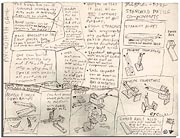
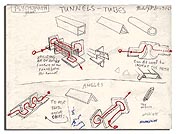
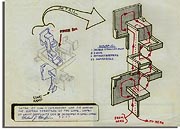
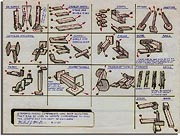
One month to the day after marrying my fiancée, Becky, I again embarked on the toy journey. This same month I began teaching my first art class at SRJC. At this point, the game was still called “Psychopath”.
Thinking again about component pieces, I finally began to define the basic elements: on ramps, straight-aways, drops, pathway inverters, complex inverters, single and double sided ramps, angles, guard rails, tunnels and tubes, transfer rails, and finish boxes. One could even design a game with multiple pathways; for beginner, intermediate, and expert. Injection molded plastic parts could be cemented together. It occurred to me that, “a box is easier to handle and store than a sphere”. (Looking back, I can now see how the cube informed rectangular and straight designs, and the sphere, which is more difficult to design into, informs arcs and circles.)
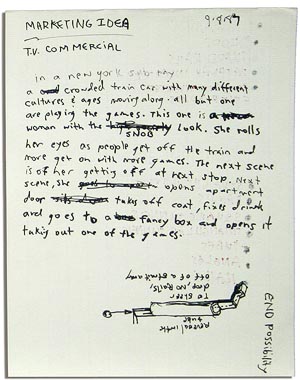
Several TV commercial ideas came to me. Here’s one, “in a New York subway a crowded train car with many different cultures and ages moving along. All but one are playing the games. This one is a woman with the snob look. She rolls her eyes as people get off the train and more get on with more games. The next scene is of her getting off at the next stop. Next scene, she opens apartment door, takes off coat, fixes drink and goes to a fancy box and opens it taking out one of the games”.
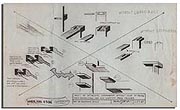
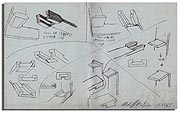

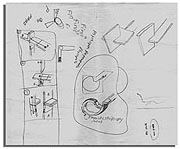
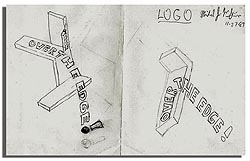
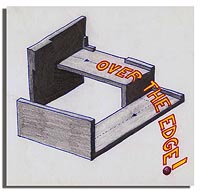
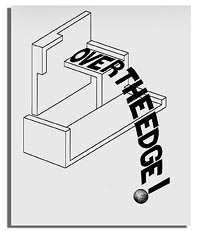
For me, teaching even one class was an all-consuming task. Luckily, the Thanksgiving holidays afforded time to work on the game... and to change the name. OVER THE EDGE was friendlier, and had a similar double-meaning as PSYCHOPATH. “This game will drive you Over The Edge!” The first “pivot” design came to mind, along with a magnetic strip allowing the ball to roll “upside-down”, and better ways to attach the game to the cube. Snap-fitting parts together could eliminate cementing. The refined logo image (to the right) was actually produced on a computer 14 months later for the design proposal described at the bottom of this page.
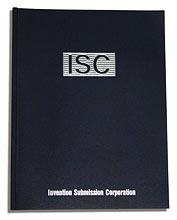
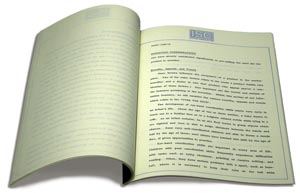
Feeling like the father of Michael J. Fox’s character in Back To The Future, I felt myself boiling up with anticipation, unable to make that punch! Somehow I HAD to get the game going. Becky and I owned no television, so we listened to a lot of AM talk shows. Bruce Williams was our favorite. One commercial that persistantly played was for a company called, “Invention Submission Corporation”, or ISC. “Do you have an idea, or know someone who does...”. We did! But what if they are a scam? Well, why would our local and trusted KSRO Radio advertise a scam? So we took the plunge. Several phone calls and mailings later, we had a contract for them to produce a 32 page report. The cost, $500! This was a large amount of money to us. Like most people who went through this company, we were under the impression that this report was a patent application (a submission, if you will). Boy, were we wrong!
In January of 1988, we received the much-anticipated report. It was a generic, single-sided, double-spaced, pile of useless information. For one thing, they didn’t understand that Over The Edge was not a picture puzzle. Anywhere text was written specifically addressing my game, it was a direct quote from my writing. The majority of the report was drop-in information like, “Distribution Channels: Once the potential market targets for a new product have been identified, consideration should be given to identifying the types of outlets where the product could potentially be distributed to those market targets.” No Kidding!
When I called ISC to discuss the lack of useful information, they tried to make us pay another $2000 to provide information which could eventually, potentially, lead to a patent attorney. We were horrified, very embarrassed, and even ashamed at our naïveté. My parents, who believed in me, were willing to loan us the money (with no interest), if I wanted it. This kind of trust cannot be abused.
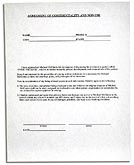
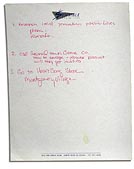
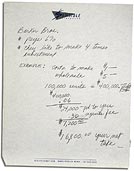
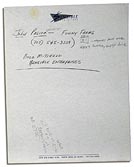
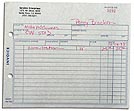
The ISC report was useless, so on the advice of our friend, Greer Upton (spouse of John Watrous), Becky and I met with Penny Bracken. She had a consulting business called “$ensible Enterprises”. Penny hoped to help us get the game marketed. For a fee of $25 (one hour), Penny gave us some example royalty figures and a contact with a possible investor named Joe Pascoe. If we made a license agreement, she would take 30%.
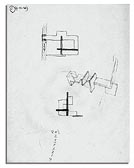
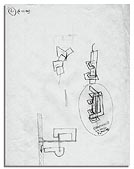
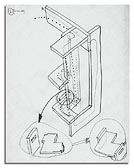
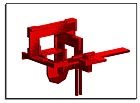
I think Penny may have suggested creating a proposal for the game. At any rate, it was again time to redesign. The latest version would contain two discrete “mazes” intertwined, or at least disconnected from one-another. The ball would fall from one unit onto another. It was very difficult to visualize. I was afraid of making a model because I had no shop, tools, or space. But I did have a borrowed Apple Computer. So with very few sketches, I created a 3-D model. It was so time-consuming that I only completed one of the units. I thought the accuracy of the computer could directly translate to manufacturing processes. Not true. As seen in the design proposal below, I eventually drew the other unit without modeling it in 3D.
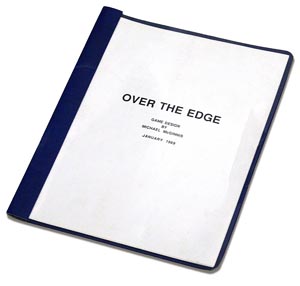
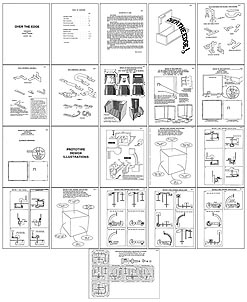
The design proposal for Over The Edge took all winter break to produce. It was 19 pages long. You can see the report; I think it is rather ugly and with no aesthetic appeal, but at the time it was the best I could do. The images were drawn in SuperPaint and placed into PageMaker. I really hated Pagemaker! Now those old file formats cannot be opened. Joe Pascoe met with us, signed a non-disclosure agreement, looked at my report, and turned us down. Other leads went nowhere (LaserCraft, Animal Town Game Co., “Heart Song”). It was very discouraging to discover how little interest there was in the idea. I felt completely helpless and inept. Below is the Design Proposal’s Table of Contents and Page 1 (which I wrote for ISC one year earlier).
TABLE OF CONTENTS
- Description of Game
- Logo Design
- Basic Components
- Ramp Mounting System
- Enclosing Box Construction
Prototype Design Illustrations
- Perspective View
- Section 1 Trail Tracings
- Section 2 Trail Tracings
- Cube Layout For Complete Game*
- * fold-out page
page 1
DESCRIPTION OF GAME
HOW IT WORKS:
As seen in the drawings entitled, “Basic Components”, my game is made of simple components which can be arranged and intermixed into very complex and difficult designs. A small metal ball and the game components are enclosed in a clear plastic box. One manipulates the ball to roll along the component ramps, tunnels, drops, etc..., by means of rotating and flipping the box. Hand-eye coordination and patience are needed to get the ball from start to finish.
UNIQUE FEATURES:
The entire inside surface of the box is used as a means of getting the ball to the starting ramp. Once the ball’s journey begins there is no up, down, left, or right to the game; only a momentary rotation to keep gravity from pulling the ball off of the ramp system. The overall length the ball must travel is potentially quite long. The prototype design illustrated herein has a working distance of approximately 40 inches – in a box 3.5 inches square. All or most of the components’ surfaces can be utilized to achieve very compact and efficient designs.
ADVANTAGES OVER SIMILAR PRODUCTS:
This game can be very difficult to finish, yet still be very engaging. Unlike other games with rolling ball bearings, “Over The Edge” can keep one’s interest for weeks at a time. It is not a puzzle; there is no trick to solving this game. Satisfaction can be had merely by getting further along than the day before. I’ve had friends play with my balsa wood model for weeks, and while never completing it, are proud of their accomplishments. This game has more advantages in that standard components can be made and arranged in a wide variety of ways to make many levels of difficulties and challenges. A series of “Over The Edge” games can be developed: “Child’s Play”, for children; “Challenger”, the basic model, “Double Trouble”, two intertwined yet distinct games in the same box; “The Professional”, for competition; etcetera.
WHO WILL USE THIS GAME:
Anyone interested in either noncompetitive or highly competitive games and puzzles will wish to play. The players’ main objective is to attain a satisfaction with playing the game and to create a strong desire to show others one’s accomplishments. This game will be found challenging by those who quickly become bored with simple ball bearing puzzles, and can be used to develop better hand-eye coordination skills.
CONCLUSION:
I believe this game has a great chance for success; the potential market is tremendous. The response I’ve received from those who have had access to my model leads me to believe strongly in my concept, and the prototype design presented is but one possibility of design.
Michael McGinnis